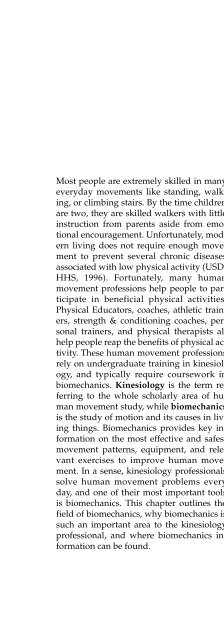Fundamentals of Biomechanics
Fundamentals of Biomechanics
Fundamentals of Biomechanics
You also want an ePaper? Increase the reach of your titles
YUMPU automatically turns print PDFs into web optimized ePapers that Google loves.
Most people are extremely skilled in many<br />
everyday movements like standing, walking,<br />
or climbing stairs. By the time children<br />
are two, they are skilled walkers with little<br />
instruction from parents aside from emotional<br />
encouragement. Unfortunately, modern<br />
living does not require enough movement<br />
to prevent several chronic diseases<br />
associated with low physical activity (USD-<br />
HHS, 1996). Fortunately, many human<br />
movement pr<strong>of</strong>essions help people to participate<br />
in beneficial physical activities.<br />
Physical Educators, coaches, athletic trainers,<br />
strength & conditioning coaches, personal<br />
trainers, and physical therapists all<br />
help people reap the benefits <strong>of</strong> physical activity.<br />
These human movement pr<strong>of</strong>essions<br />
rely on undergraduate training in kinesiology,<br />
and typically require coursework in<br />
biomechanics. Kinesiology is the term referring<br />
to the whole scholarly area <strong>of</strong> human<br />
movement study, while biomechanics<br />
is the study <strong>of</strong> motion and its causes in living<br />
things. <strong>Biomechanics</strong> provides key information<br />
on the most effective and safest<br />
movement patterns, equipment, and relevant<br />
exercises to improve human movement.<br />
In a sense, kinesiology pr<strong>of</strong>essionals<br />
solve human movement problems every<br />
day, and one <strong>of</strong> their most important tools<br />
is biomechanics. This chapter outlines the<br />
field <strong>of</strong> biomechanics, why biomechanics is<br />
such an important area to the kinesiology<br />
pr<strong>of</strong>essional, and where biomechanics information<br />
can be found.<br />
CHAPTER 1<br />
Introduction to <strong>Biomechanics</strong><br />
<strong>of</strong> Human Movement<br />
3<br />
WHAT IS BIOMECHANICS?<br />
<strong>Biomechanics</strong> has been defined as the study<br />
<strong>of</strong> the movement <strong>of</strong> living things using the science<br />
<strong>of</strong> mechanics (Hatze, 1974). Mechanics is<br />
a branch <strong>of</strong> physics that is concerned with<br />
the description <strong>of</strong> motion and how forces<br />
create motion. Forces acting on living<br />
things can create motion, be a healthy stimulus<br />
for growth and development, or overload<br />
tissues, causing injury. <strong>Biomechanics</strong><br />
provides conceptual and mathematical<br />
tools that are necessary for understanding<br />
how living things move and how kinesiology<br />
pr<strong>of</strong>essionals might improve movement<br />
or make movement safer.<br />
Most readers <strong>of</strong> this book will be majors<br />
in departments <strong>of</strong> Kinesiology, Human<br />
Performance, or HPERD (Health, Physical<br />
Education, Recreation, and Dance). Kinesiology<br />
comes from two Greek verbs that<br />
translated literally means “the study <strong>of</strong><br />
movement.” Most American higher education<br />
programs in HPERD now use “kinesiology”<br />
in the title <strong>of</strong> their department because<br />
this term has come to be known as<br />
the academic area for the study <strong>of</strong> human<br />
movement (Corbin & Eckert, 1990). This<br />
change in terminology can be confusing because<br />
“kinesiology” is also the title <strong>of</strong> a<br />
foundational course on applied anatomy<br />
that was commonly required for a physical<br />
education degree in the first half <strong>of</strong> the<br />
twentieth century. This older meaning <strong>of</strong><br />
kinesiology persists even today, possibly






